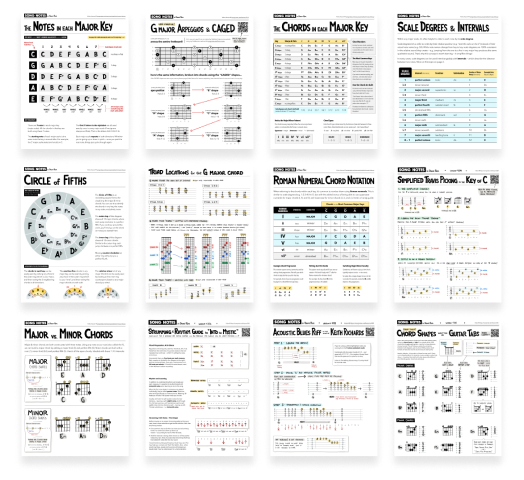Open chords in the Key of A
Lesson #206 • Jan 12, 2019
Video Overview
Instructional PDF 3 pages
Editor’s notes
In this lesson, I’ll show how you can warm up by playing all the chords in the key of A with open voicings. Specifically, you’ll be leaving the 1st and 5th strings open for all chord shapes - which allows you to play the Bm, C#m, and F#m as simple open chords (as opposed to these being played via barre chords). This results in a large handful of chords that are easy to switch between, sound great together, and otherwise make for great warm up fodder.
The typical way to play chords in the key of A
First, let’s understand how to “normally” play these chords in the key of A-major. Going up the fretboard we have:
e –––0––––2––––4––––5––––7––––9––– –––5–––
B –––2––––3––––5––––7––––9–––10––– –––5–––
G –––2––––4––––6––––7––––9–––11––– –––6–––
D –––2––––4––––6––––7––––9–––11––– –––7–––
A –––0––––2––––4––––5––––7––––9––– –––7–––
E –––––––––––––––––––––––––––––––– –––5–––
A Bm C#m D E F#m A
Of course, you could play the D and E chords in an “open” voicing, as shown below - but you’re still left w/ the problem of the Bm, C#m and F#m all using barre chords. In a moment, I’ll explain a way to avoid barre chords altogether and embrace open voicings for all the chords.
e –––0––––2––––4––––2––––0––––9––– –––5–––
B –––2––––3––––5––––3––––0–––10––– –––5–––
G –––2––––4––––6––––2––––1–––11––– –––6–––
D –––2––––4––––6––––0––––2–––11––– –––7–––
A –––0––––2––––4–––––––––2––––9––– –––7–––
E –––––––––––––––––––––––0–––––––– –––5–––
A Bm C#m D E F#m A
Those same chords, but with open voicings
Here, we’re going to make the sweeping change (for all of the chords) of leaving the 1st and 5th strings open. Meaning, we’re not going to press down frets on those strings - no matter what the chord is.
e –––0––––0––––0––––0––––0––––0––– –––0––– <== leave open for all chords
B –––2––––3––––5––––7––––9–––10––– –––5–––
G –––2––––4––––6––––7––––9–––11––– –––6–––
D –––2––––4––––6––––7––––9–––11––– –––7–––
A –––0––––0––––0––––0––––0––––0––– –––0––– <== leave open for all chords
E –––––––––––––––––––––––––––––––– –––––––
A Bm C#m D E F#m A
Here are those same shapes (in tab form), without the 1st 2nd or 6 strings typed out. You should still play those 2 strings (leave them open) - but the focus here is to notice the chord shapes you’re using. Look for patterns. For example, the A D and E chords all use the same shape on the 2nd, 3rd, and 4th strings. Likewise, the Bm C#m and F#m all use their own same shape (the same as the A-minor shape).
e –––––––––––––––––––––––––––––––– –––––––
B –––2––––3––––5––––7––––9–––10––– –––5–––
G –––2––––4––––6––––7––––9–––11––– –––6–––
D –––2––––4––––6––––7––––9–––11––– –––7–––
A –––––––––––––––––––––––––––––––– –––––––
E –––––––––––––––––––––––––––––––– –––––––
A Bm C#m D E F#m A
Quick note on finger positions
For the major chords, use either of these finger positions:
e –––0––––0––––0––– e –––0––––0––––0–––
B –––2––––7––––9––– <= left ring B –––2––––7––––9––– <= left ring
G –––2––––7––––9––– <= left middle OR G –––2––––7––––9––– <= left index
D –––2––––7––––9––– <= left index D –––2––––7––––9––– <= left middle
A –––0––––0––––0––– A –––0––––0––––0–––
E ––––––––––––––––– E –––––––––––––––––
A D E A D E
For the minor chords, use these finger positions:
e –––0––––0–––––0–––
B –––3––––5––––10––– <= left index
G –––4––––6––––11––– <= left ring
D –––4––––6––––11––– <= left middle
A –––0––––0–––––0–––
E ––––––––––––––––––
Bm C#m F#m
Now, mix and match these chord shapes!
Think of each of these chord shapes as a building block - which can be freely used & combined in any order. Keep this in mind when playing these shapes. Try out a few of them together, in a pattern, and repeat. Experiment with different strumming patterns. Play around with which strings you’re accenting. Mix it up! Especially when you’re warming up, this sort of free play can be very helpful to get the blood flowing and try something new.
Exercise #1:
e –––0––––0––––0––––0––––
B –––2––––3––––5––––3––––
G –––2––––4––––6––––4––––
D –––2––––4––––6––––4––––
A –––0––––0––––0––––0––––
E –––––––––––––––––––––––
A Bm C#m Bm
Exercise #2:
e –––0––––0––––0––––0––– e –––0––––0––––0––––0–––
B –––2––––7––––9––––7––– B –––5––––7––––9––––7–––
G –––2––––7––––9––––7––– G –––6––––7––––9––––7–––
D –––2––––7––––9––––7––– or D –––7––––7––––9––––7–––
A –––0––––0––––0––––0––– A –––0––––0––––0––––0–––
E –––––––––––––––––––––– E ––––––––––––––––––––––
A D E D A D E D
Exercise #3:
e ––––0––––0––––0––––0––––
B –––10––––9––––7––––9––––
G –––11––––9––––7––––9––––
D –––11––––9––––7––––9––––
A ––––0––––0––––0––––0––––
E ––––––––––––––––––––––––
F#m E D E
Exercise #4:
e –––0––––0––––0––––0–––
B –––5––––5––––3––––2–––
G –––6––––6––––4––––2–––
D –––7––––6––––4––––2–––
A –––0––––0––––0––––0–––
E ––––––––––––––––––––––
A C#m Bm A
Exercise #5:
e –––9––––0––––0––––0–––
B –––10–––9––––7––––9–––
G –––9––––9––––7––––9–––
D –––11–––9––––7––––9–––
A –––0––––0––––0––––0–––
E ––––––––––––––––––––––
A E D E
You can also do this with the key of E
If you enjoy this way of playing, check out this video - where I show the same exact approach but used for chords in the key of E.
Good luck!
I hope this was helpful. As always, I encourage you to be in touch with any questions.
Enjoy my lessons? Buy me a beer!
If this and my other lessons have proven helpful to you, please consider making a one-time donation to my tip jar. Contributions of any amount help make this project possible (including the many, many hours I put into it).
Fun & Helpful Tools I've Made
Subscribe to my YouTube channel
Be sure to never miss a lesson by subscribing on YouTube. I put out 2-3 new videos every week. These include full song lessons, as well as covers, practice tips, behind-the-scenes updates. Thanks!
Recent Lessons
-
April 18, 2024
"Moonshadow" by Cat Stevens
-
April 9, 2024
Chords & Music Theory... 9 New Lessons!
-
March 30, 2024
Gordon Lightfoot's "Carefree Highway"
-
March 22, 2024
Lead Guitar & the F1 Theme Song
-
March 15, 2023
Pink Floyd's "Breathe" - with Simpler Chords Included
-
March 6, 2024
Q&A: 8 Tips to Avoid Muting Strings
-
March 1, 2024
Blues Shuffle Riffs - Using Just 2 Strings!
-
February 16, 2024
Soulful Lead Guitar with "America the Beautiful"
-
February 8, 2024
Country Honk by The Rolling Stones
-
January 31, 2024
Beginner Blues - New Course Sneak Peek!


